Article and all photos by Joe Mock, BaseballParks.com
All rights reserved
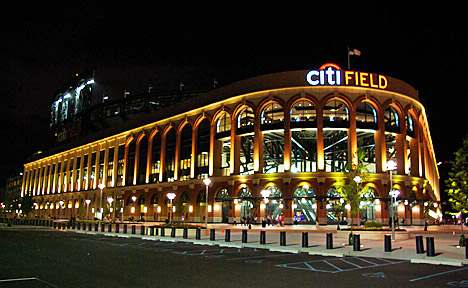 |
Since the Yankees and the Mets both opened their super-expensive new playgrounds the same year, comparisons between new Yankee Stadium and Citi Field are inescapable. However, please allow me to start this review in an unconventional way: by comparing the Yankees’ and Mets’ parks in the New York/Penn League. You’ll see why.
| Ballpark Stats |
 |
| Team: The New York Mets |
| First game: April 13, 2009, a 6-5 loss to San Diego |
| Capacity: 41,800 |
| Architect: Populous (formerly called HOK) |
| Construction: Hunt-Bovis |
| Price: $800 million |
| Home dugout: first-base side |
| Field points: north by northeast |
| Playing surface: Kentucky bluegrass |
| Betcha didn’t know: Citi Field has 15,554 fewer seats than Shea Stadium |
The Staten Island Yankees play their home games in Richmond County Bank Ballpark, on the northern shore of Staten Island. It was designed by HOK (now called Populous), the kingpins of Major League ballpark architecture. At the time it was built, it was one of the most-expensive minor-league parks ever constructed. As befits a team with the nickname “Yankees,” the ballpark is quite stately. The sight lines are excellent, the concessions are fine, and the atmosphere at games borders on having a big-league feel. There is nothing the least bit quirky. There are no cutesy, off-the-wall souvenir items here, as the merchandise tends to emphasize the unmistakable “Yankee” insignia. I have no problem with any of that.
The Mets’ New York/Penn League team plays its home games at Keyspan Park in the Coney Island section of Brooklyn. The architects for the facility weren’t nationally known ballpark designers. The seating bowl is somewhat quirky, with wavy awnings over parts of the concourse, and crazy-colored lighting under those awnings. Neon rings of various colors encircle the banks of lights at the tops of the lighting towers. The concessions tend toward amusement-park foods, and the lovely two-level souvenir shop is filled with wonderful, creative, colorful merchandise that emphasizes the fun of attending a game here. The team that plays in this ballpark, in fact, isn’t known as the Brooklyn Mets. Instead, they are the Brooklyn Cyclones, named for the famous roller coaster just two blocks away from the park’s left-field fence. And I have no problem with any of this.
When you compare the two ballparks — built at roughly the same time for the same level of the Minors — you come to understand the central difference between new Yankee Stadium and Citi Field. One is serious and tries way too hard to convey that the park’s tenants are to be revered. The other embraces the fact that baseball is a pastime to be enjoyed by families … and that families have kids that like to have fun when they come to a game.
Frankly, I’ll take the fun over the solemnity any day.
But Citi Field is far more than just fun. Its exterior and its design are the equal of any ballpark in the big leagues. In fact, there are only two aspects of the park that bother me (and one of those is being corrected). Otherwise, it’s about as perfect as a park can be.
How much did this near-perfection cost? Well, the Mets say that their investment topped $600 million. Infrastructure work paid for by the state added another $75 million to the project, and the city contributed about $90 million in capital funds. All told, right around $800 million was spent creating Citi Field. And as I noted in the review of new Yankee Stadium, this $800 million was better spent than the $1.5 billion in the Bronx.
So let’s examine the park’s location (in which we’ll explore Citi Field’s most significant drawback), its jaw-dropping exterior, its architectural design and its many, many amenities for the fans.
The Setting
I love Citi Field so much that I almost hate to talk about its setting first. On second thought, maybe it’s better to get it out of the way.
As you probably know if you watched any Mets games on TV in 2008, the new park was constructed in the parking lots of Shea Stadium. In fact, the new facility is just beyond the center field wall of the old place. It was a little frustrating in 2008, because so many parking spaces were wiped out, but once 2009 was fully underway, and there is no hint that Shea ever existed (it’s all parking lots now), the onsite parking is again plentiful, with 8,300 spaces.
The problem with the expedient decision to construct Citi Field between Shea and 126th Street, which has always been the eastern boundary of the huge block of land for the stadium and its lots, is what is along 126th Street. It ain’t pretty.
 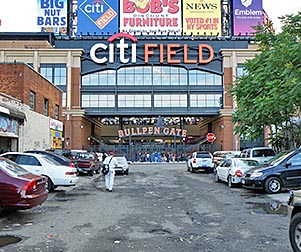 |
All along the east side of 126th Street, and for several blocks heading away from the stadium site, are dozens of establishments that I will politely call auto-repair shops. I’ve seen this batch referred to as chop shops, but you can call them what you want. They are seedy and unsightly, and the side streets running away from 126th Street are full of potholes and are littered with the types of vehicles that Cash For Clunkers was supposed to get rid of.
This is no small point. That side of the street, just a few feet away from the right-field exterior of Citi Field, looks absolutely horrendous. Frankly, I was shocked to see this area so close to the beautiful $800 million showplace. I’m sure those businesses have the legal right to be there, and I’m not a big fan of “eminent domain” to shut down legitimate merchants, but if there was ever a reason to clear out an area that is an eyesore, this would be it.
As you’ve no doubt heard while watching Mets games on TV, a lot of very loud planes fly over the ballpark. That’s because LaGuardia Airport is just to the northwest of the site. When planes are landing here, just before they hit the runways, they fly over Flushing Bay, which is the body of water you can see from the upper deck of Citi Field when you look to the north (below left). This bay connects to the Long Island Sound.
There is also no shortage of freeways very close to the ballpark, and you will want to be very careful to watch for your correct exit, because if you miss it, you could find yourself a long way away from where you want to be with no easy way to turn around (do I sound like I’m speaking from experience?). Running just to the north of the stadium is the short 25A connector road between Grand Central Parkway (which runs next to LaGuardia) and I-678, which is known as the Whitestone Expressway north of this point, and the Van Wyck Expressway to the south.
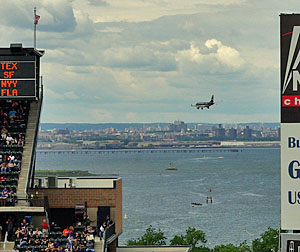 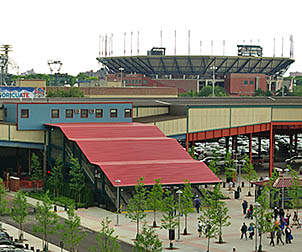 |
As is the case with new Yankee Stadium, the NYC transit system will bring you right to Citi Field. The significantly renovated Mets-Willets Point station (still called Willets Point-Shea on some maps) of the 7 train will deliver you to the south side of the park. The tracks are elevated above Roosevelt Avenue here. This line runs into Grand Central Station in Manhattan, by the way.
About 200 yards south of this station is another train station — this one for the Port Washington branch of the Long Island Rail Road. It runs all the way to Penn Station in Manhattan.
By the way, there are some points of interest nearby. Just across Roosevelt Avenue — as well as some railroad tracks — is the USTA National Tennis Center, where the U.S. Open Tennis Tournament is played each summer. In the photo on the right side above, you can see the Arthur Ashe Stadium beyond the train station. Just to the south of the tennis complex is the part of Flushing Meadows Park where the 1964 World’s Fair was held. Some of the remnants of the fair’s structures, such as the famous Unisphere, still exist. And just to the west of that, across the Grand Central Parkway, is the Queens Zoo.
The Exterior
Without a doubt, Citi Field possesses one of the most beautiful exteriors of baseball’s “new wave” of ballparks that have appeared over the last two decades. It has a very classic look — and that’s no coincidence, because its exterior was designed to pay homage to one of the most “classic” parks of all time: Brooklyn’s Ebbets Field.
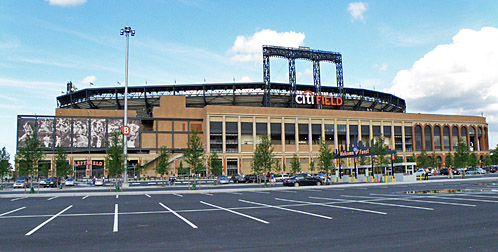 |
Even before the Mets learned that their long-time desire to have a replacement for Shea would become a reality, there was a lot of buzz in the ballpark world. The word was that the new facility would be a modern-day duplication of the Brooklyn Dodgers’ home for 45 seasons.
As renderings started to emerge of the proposed ballpark, it became obvious that the cramped concourses and odd angles in Ebbets Field would not be reproduced in the new facility. While its classic brick look would be copied, only one aspect of its exterior would be a direct duplication — unlike new Yankee Stadium that borrowed very, very heavily from the original park that opened in 1923. The lone element that would duplicated for the Mets was the home-plate entry that contained Ebbets’ famed rotunda.
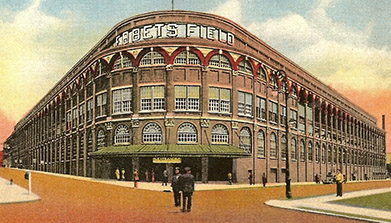 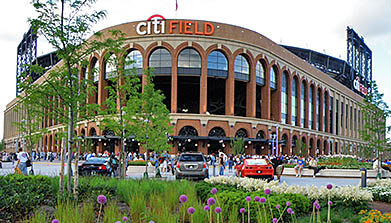 |
While very few pictures of the interior of that rotunda remain, there are plenty of photos and images of that part of Ebbets’ exterior. For instance, see the top image above, which was a vintage postcard that was reproduced by Found Image Press for their excellent line of note cards. Now compare that to Citi Field’s home-plate entry today. Coincidence? I think not.
Populous’ designers did a phenomenal job bringing this exterior look to a modern-day ballpark, right down to the contrasting brick colors used around the arching openings. And as we will see in the next section, the interior of the rotunda is even more spectacular.
The look of the arches isn’t carried out all the way down the southern and western exteriors, but where it exists near the rotunda, it is truly spectacular — and it is even more so at night, as you can see at the very top of this page.
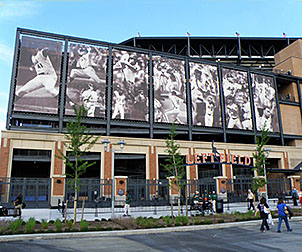 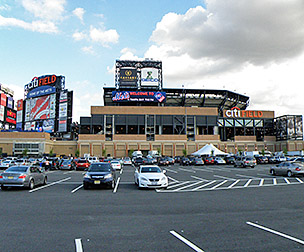 |
If you walk the perimeter of the ballpark going clockwise, you’ll pass over Shea Stadium’s former footprint, now immaculately demolished and paved over with much-needed parking spaces. The photo at the top of this section was taken from the location of Shea’s exterior walls behind home plate.
At the northern end of the long, straight exterior of Citi Field (that runs roughly parallel to the third-base line), you’ll find the left-field gates (above left). If you enter here, you’ll then need to walk up ramps or take an escalator up to the main concourse. One other feature here is a set of larger-than-life photos of great Mets, starting with Tom Terrific — otherwise known as Tom Seaver. While such a set of large pictures wouldn’t be unique at other new ballparks, it is here … which brings me to the second troubling aspect of this park: there isn’t much about it that says “Mets.”
Unlike new Yankee Stadium, which essentially screams out “New York Yankees, Winners Of 26 World Series” with every brick and slab of concrete, Citi Field really doesn’t have much to say about the New York Mets. These photos at the left-field gate not withstanding, some of the criticism directed at this new park has been that it seems to hearken back to the Brooklyn Dodgers more than the history of the Mets. About six weeks after my visit, though, the team started installing a number of additional banners showing current and past Mets players. The front office obviously heard the gripes and started doing something about it.
As you continue through the parking lots around to the north side of the park’s footprint, you encounter the more utilitarian part of the park (above right). Here are the loading docks and spots for 18-wheelers to park. While this is not an ugly face to show to the outside world (and this is the side that a lot of passersby will see as they zip along the 25A connecting road), it’s the least pretty of the four sides of the structure. It’s too bad that this less-showy side couldn’t have been on the east side, across the street from the hideous auto-repair places.
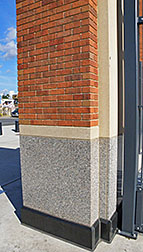 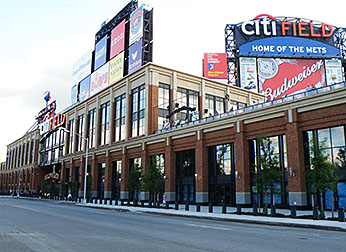 |
This is a good spot to take note of the construction materials used in the park’s exterior (above left). Here you see the brick, made of a hue reminiscent of Ebbets Field, above limestone and granite. This is a gorgeous, classic look.
As you travel on around the park, we come to the aforementioned 126th Street, with its unappealing (to put it mildly) car-repair shops. The side of the ballpark on the other side of the street is, in contrast, quite attractive, with an exterior that is complementary to (but not a duplication of) the southern and western sides of the park. As you can see in the right-hand shot above, on the upper level on the right side is the plaza containing the 2K Sports Fan Fest and other attractions geared to the younger set. Toward the left of the the upper level is the back of the building containing a couple of stores, an ice cream shop and some offices. On the lower level is the Bullpen Gate, which opens into a large lobby area inside the gates. Here is where you’ll find the original home-run apple that used to appear when the Mets hit one out at Shea. The apple that is in center field at Citi Field is a new, improved version.
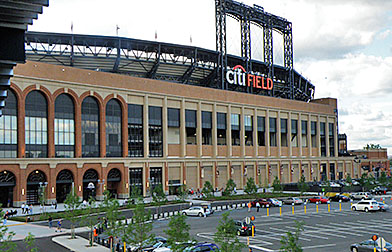 |
Finally, we come to the southern side of Citi Field’s trapezoid. The photo above shows the view from the train station of the 7 line, with the rotunda end on the left side of the shot and the exterior entry to the main souvenir shop is close by. The Right Field Gate is on the extreme right side of the picture.
All in all, a spectacular exterior. It’s only marred by the ugly surroundings on its east side.
The Design
If you set aside that the neighborhood is awful to the east of the park, and that there aren’t enough “Met” elements there, I think you’d conclude that Citi Field is wonderful. This is especially true of its architectural design. If anything, there are too many features and places to explore in just one or two games! I came for two games, and I feel like I failed to adequately check out every aspect that I would’ve liked to.
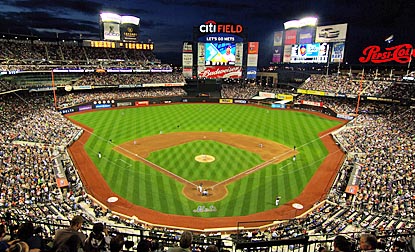 |
We’ll save the very best architectural element (the rotunda) for last … so let’s start with a level-by-level look at this baseball wonder.
The ballpark with an overall interior design that reminds me most of Citi Field is Busch Stadium in St. Louis. Both are parks with immense footprints but intimate seating bowls — leaving a lot of room for outfield plazas, wide concourses and lots of points of sale for concessions and souvenirs.
The lowest seating section at Citi Field has two-digit and 100-series section numbers, and is known as the Field Level. Nearest the backstop (below left) is the ultra premium Sterling area, with its four levels of Delta Club (which have padded, 24″ wide seats — below right). These are sections 1 through 19 and are mostly sold as season tickets. In case you’re curious, the most expensive of these seats for the most expensive games (i.e., against the Yankees) are $695. High, yes, but they pale in comparison to the price of comparable seats in the Bronx.
By the way, I couldn’t resist taking a photo of the seat with its own TV screen (below center). The usher who works that section told me that it was “the seat of the boss,” which I took to mean that it is where Fred Wilpon sits.
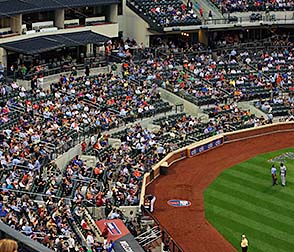 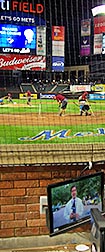 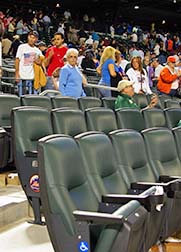 |
The Field Level actually circles the entire field, so this is the level that offers the 360-degree concourse. While this isn’t an “open concourse” behind home plate due to the private Ebbets Club (that has beautiful etched glass, by the way), it is open the rest of the way around. There are loads of concession stands and kiosks on your trek around, but the highlight on this level has to be the 2K Sports Fan Fest in center field beyond the batter’s eye. We’ll discuss this area in more detail in the next section, but this is where you’ll find numerous features that kids will love.
Connecting this area in center field with the right-field corner is an interesting metal bridge (below right). “The structural steel ‘bridge’ motif throughout Citi Field reinforces the Mets’ connection to New York’s five boroughs,” says the team’s media guide, in case you were wondering. On the field side of this bridge is a uniquely shaped seating section, called appropriately the Bridge Terrace, and below that are the bullpens. On the street side of the bridge is the wide street-level plaza just inside the Bullpen Gate.
By the way, my favorite food area in the park is on the Field Level in the right-field corner. It’s called World’s Fare Market.
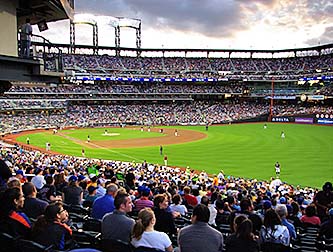 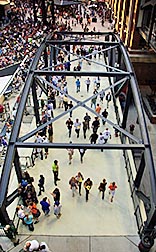 |
One level up is the Empire Level, but it’s not open to the general public. Here you’ll find the Empire Suites. The Excelsior Level is up from that, and it includes sections numbered 301 – 339 — most of which are club seats. The Acela Club is in the left-field corner of this level, and the massive Caesars Club (below left — note the curving windows, which you can see from the outside of the park behind home plate), which sits directly above the rotunda, is behind the press box. As an aside, unlike at Busch Stadium, the press area at Citi Field is phenomenal.
The most interesting part of this level is the Pepsi Porch (below right), which is high above right field. You can see the huge Pepsi logo at the back of the area from almost everywhere in the park. This porch is fascinating for two reasons. First, it is multi-leveled, with stairs connecting the two levels of the plaza which is perfect for milling around. Second, the front of the 1,284-seat seating section extends out over the field of play by eight feet, which is reminiscent of the upper deck at old Tiger Stadium.


The very top section is the Promenade Level, and it contains a total of 15,500 seats in sections numbered 401 to 437 and 501 to 538. Behind the 400-section seats and below the 500-section seats is an enormous 40-foot-wide concourse — which is even wider behind home plate. This circular area is a large food court (below left), and it is directly above the rotunda and Caesars Club.
This upper concourse, though, has one flaw. If there were an opening between the concession stands and restrooms anywhere along the concourse on the third-base side, you would have a magnificent view of Manhattan. Alas, there is no such opening, and this is a missed opportunity to have a much-talked-about view.
I’m happy to say that there is a classic baseball roof over the 500-level seats, one that finishes off the look of this retro-inspired ballpark very nicely. I’m even happier to say that there’s nothing hanging down from the facing of the roof that gets in the way of your view of the rest of the park from the upper rows of these sections (unlike the frieze at new Yankee Stadium) … except in the farthest reaches of left field. Here the out-of-town scoreboard hangs down from the front of the roof, preventing an unfettered, panoramic view of the entire ballpark (below right). At least they mount some TV monitors on the back side of the scoreboard to help out those sitting in these nose-bleed seats.
 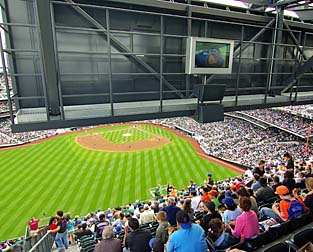 |
As is the case at all well-meaning modern-day ballparks, there are “green” initiatives in the stadium’s construction and design. For instance, construction vehicles were fueled by low-sulfur diesel, and almost all of the structural “skeleton” of Citi Field is recycled steel. There’s also what’s called a “green roof” on top of the administration building of the park, and an automated system that controls all of the thermostats and lights in the whole facility.
But what about the really exciting feature of Citi Field? Yes, it’s the rotunda (below).
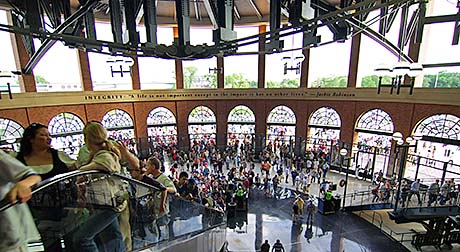 |
For years, I’ve said that the best “ballpark feature” at any baseball facility are the fountains in the outfield of Kauffman Stadium in Kansas City — a city which is nicknamed The City of Fountains. And frankly, there wasn’t a close second.
Now there is.
The Jackie Robinson Rotunda at Citi Field is positively fabulous. Yes, there are entry rotundas at PNC Park and Safeco Field, but nothing like this. Gorgeous both outside and in, this Ebbets Field-inspired space is more than just pretty. And it doesn’t just pay homage to the baseball pioneer who broke the color barrier in 1947 with the Brooklyn Dodgers. It honors the nine values that he lived by, as described in the book “Jackie’s Nine: Jackie Robinson’s Values to Live By” by Robinson’s daughter Sharon.
Indeed, the definition of integrity is found on the inner wall over the entry gates. The values of citizenship, courage, determination, persistence, justice, teamwork, commitment and excellence are described in panels set in the floor in the very center of the rotunda.
One of the most popular spots within this space is under the escalators, where a large, blue “42” sculpture is found. There was always a long line of folks waiting to be photographed in front of these numbers.
This rotunda is a very, very special place within a very, very well-designed ballpark.
 |